The history of the city of Aquileia is rooted in the distant past, going back 2200 years: its foundation dates back toRoman times, and fortunately there are traces of this in numerous archaeological remains found in its territory. Thanks toarchaeology, it is indeed possible to reconstruct many aspects of the cities of the past: having in our hands and being able to admire ancient remains is almost like having a time machine that, from the present, takes us back to the time of the founding or to intermediate epochs in which transformations and changes took place, or it is possible to discover characteristics peculiar to a culture.
Of the remains of 2200 years ago we have evidence of this in more than one hundred artifacts, now housed at the Kunsthistorisches Museum in Vienna, and now brought back on display until October 20, 2019 at the National Archaeological Museum in Aquileia: thanks to the Aquileia Foundation, the exhibition Magnificent Returns. Aquileian Treasures from the Kunsthistorisches Museum in Vienna. Among the most significant finds to be mentioned, by virtue of their state of preservation and value, several stand out: one can start with the votive relief of Mithras, a marble work that depicts the god Mithras in the act of killing a bull, according to the myth featuring the solar deity of Persian origin: from the killing of the bull a new cosmic order began, so the scene symbolized death and rebirth at the same time. Another significant work is a marble Venus that refers to the Venus Marina and is a Hellenistic elaboration of Praxiteles’Aphrodite Cnidia, which for the first time depicted Venus completely nude. And again the Patera of Aquileia, a silver plate on which an allegory of fertility is depicted, that is, a central figure performing a sacrifice in the guise of Triptolemus, a Greek hero linked to the myth of Demeter, depicted on the right seated on a throne of spikes; in the lower part we see Gaea half-reclining next to a bull, and in the upper part the bust of Zeus accompanied by the typical attributes of the deity, the scepter and the thunderbolt. Finally, particularly detailed is the dark red vitreous gemstone that minutely depicts a racing competition in a circus: three chariots driven by charioteers with whips overhead and with horses running; presumably the setting of the scene is the Circus Maximus in Rome, from what can be seen from the architectural elements glimpsed in the background. But these are just some of the objects on display; there are many others of considerable value.
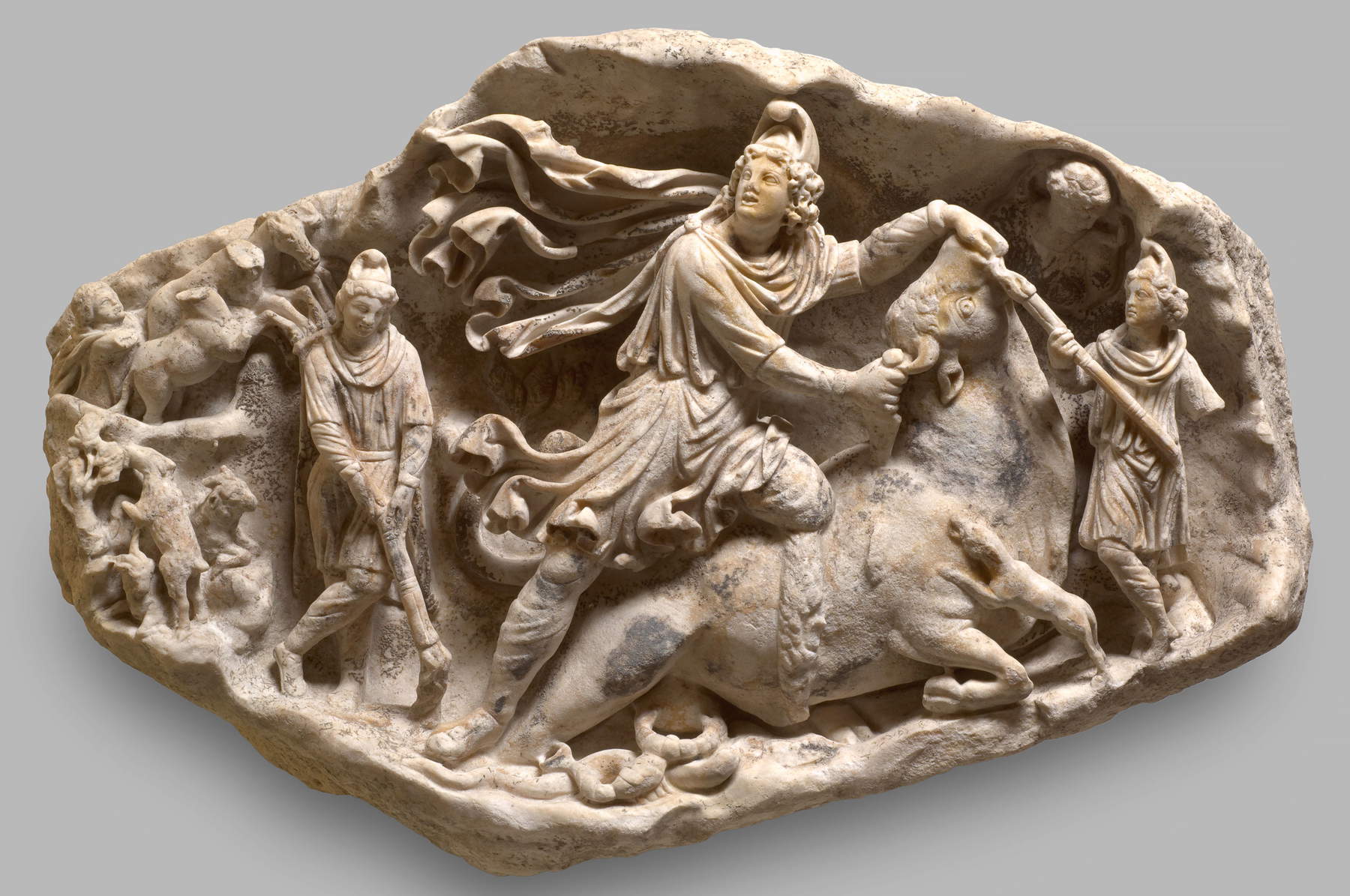 |
| Votive relief of Mithras. Ph. Credit Alessandra Chemollo, MAN Aquileia Archives |
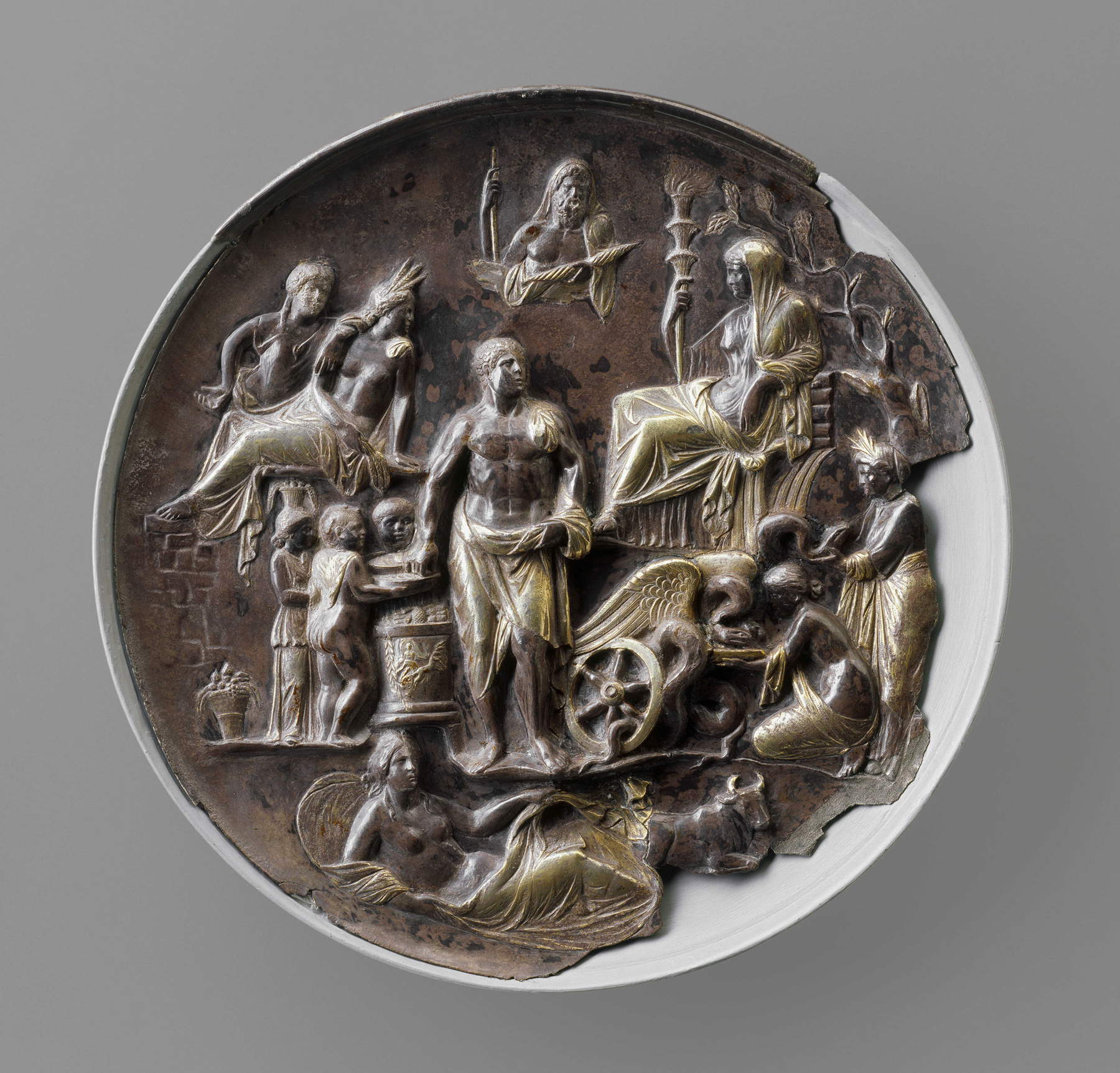 |
| Silver patera with allegory of fertility. Ph. Credit Alessandra Chemollo, MAN Aquileia archives |
 |
| Statue of female deity. Ph. Credit Alessandra Chemollo, MAN Aquileia archives |
Aquileia’s artifacts, however, tell us not only about the era in which they were produced, but also about the era in which they were found: with a leap back in time, one can go back to thenineteenth century, when throughintensive collection, excavation and research activities, significant archaeological finds were discovered underground in Aquileia, which gave insight into the importance the city had in Roman times.
With the discoveries of that era, one becomes familiar with the National Archaeological Museum of Aquileia, which reopened last August after a painstaking two-year reorganization aimed at enhancing and making more usable the masterpieces housed there: the museum’s halls accompany the visitor in the discovery of the most practical aspects of the ancient Roman city, a metropolis with an accentuated cosmopolitan, multireligious and multilingual character, given its considerable importance as a port that served the entire Mediterranean. Artifacts of common use that came from the most diverse countries, statues depicting the most diverse deities, and even portraits, inscriptions and funerary stelae tell in the museum the rich productive and commercial activity of ancient Aquileia, as well as the habits of its daily life: all artifacts found during excavations carried out on the Aquileian territory. The rearrangement involved the ground and second floors of the Villa Cassis Faraone, which has housed the permanent collection since 1882, while a second floor will house ambers, gems and coins.
However, medium- and small-scale finds, such as objects, artifacts, and tools may be, are not the only findings: it is in fact possible to breathe new life into ancient buildings that, thanks to careful interventions, make relevant parts of them still visible today. This is the case of the National Early Christian Museum of Aquileia, currently part of the Friuli Venezia Giulia Museum Pole. Although the site has been a museum site only since 1961, here the boundaries between museum and archaeological area are very blurred, in the sense that visitors explore a museum site that actually constitutes an archaeological find itself: the present complex in fact stands where one of the city’s early Christian basilicas once stood; the building has undergone numerous transformations over fifteen centuries, and the one that can now be visited is the latest. It was a Benedictine monastery from the ninth century until 1782, when a courtly decree of the Holy Roman Empire at the time of Emperor Joseph II caused its abolition, and it subsequently passed from hand to hand of various nobles; in particular, Count Antonio Cassis Faraone turned the building into the site of his Aquileian sojourns and the site of the collection of archaeological remains found on his estates or which he acquired through transfers of ownership. The complex was even used in the course of the various transformations as a folador, or wine-making room; in 1961, following excavation work for the construction of a wine cellar, polychrome mosaics were found that presented the attachment to a pentagonal apse along the outer perimeter and circular inside: from that year began the final modification of the building that would transform it into a museum venue.
Maintaining the characteristic structure of the foladors, the National Early Christian Museum is divided into three floors: on the ground floor, which coincides with the rectangular-shaped early Christian basilica with a single nave and polygonal apse (dating from the end of the 4th century), we notice a floor with geometrically patterned mosaics and inscriptions in Latin and Greek. The latter have even handed down to us the name of the donor, and it has been noted, particularly from the co-presence of Latin and Oriental, especially Syriac, names, how the basilica was used by a diverse community, consisting mostly of merchants or people connected with the port. On the second floor the structures and floor of the basilica inside the folador are visible from a balcony: a cross-shaped building with a hall divided into three naves. On display in the museum are the mosaics of the basilica from the Tullius Fund at the Beligna and some inscriptions that decorated the floor of the naves: the former feature vine shoot s sprouting from and intertwining with acanthus bushes; twelve lambs and birds, including a splendid peacock, are depicted among the clusters, and a medallion is placed in the center. These animals have risen to religious symbols: the twelve lambs are said to represent the twelve apostles, while the peacock is said to symbolize immortality, since according to ancient legends it was immune to decay. The second and final floor of the museum displays more than 130 funerary inscriptions characterized by images of the deceased, often accompanied by plants and animals. The mosaics in particular testify to ancient Aquileia’s relations with the Mediterranean, especially with North Africa and the East.
 |
| Interior of the National Archaeological Museum in Aquileia. Ph. Credit Alessandra Chemollo, MAN Aquileia archives. |
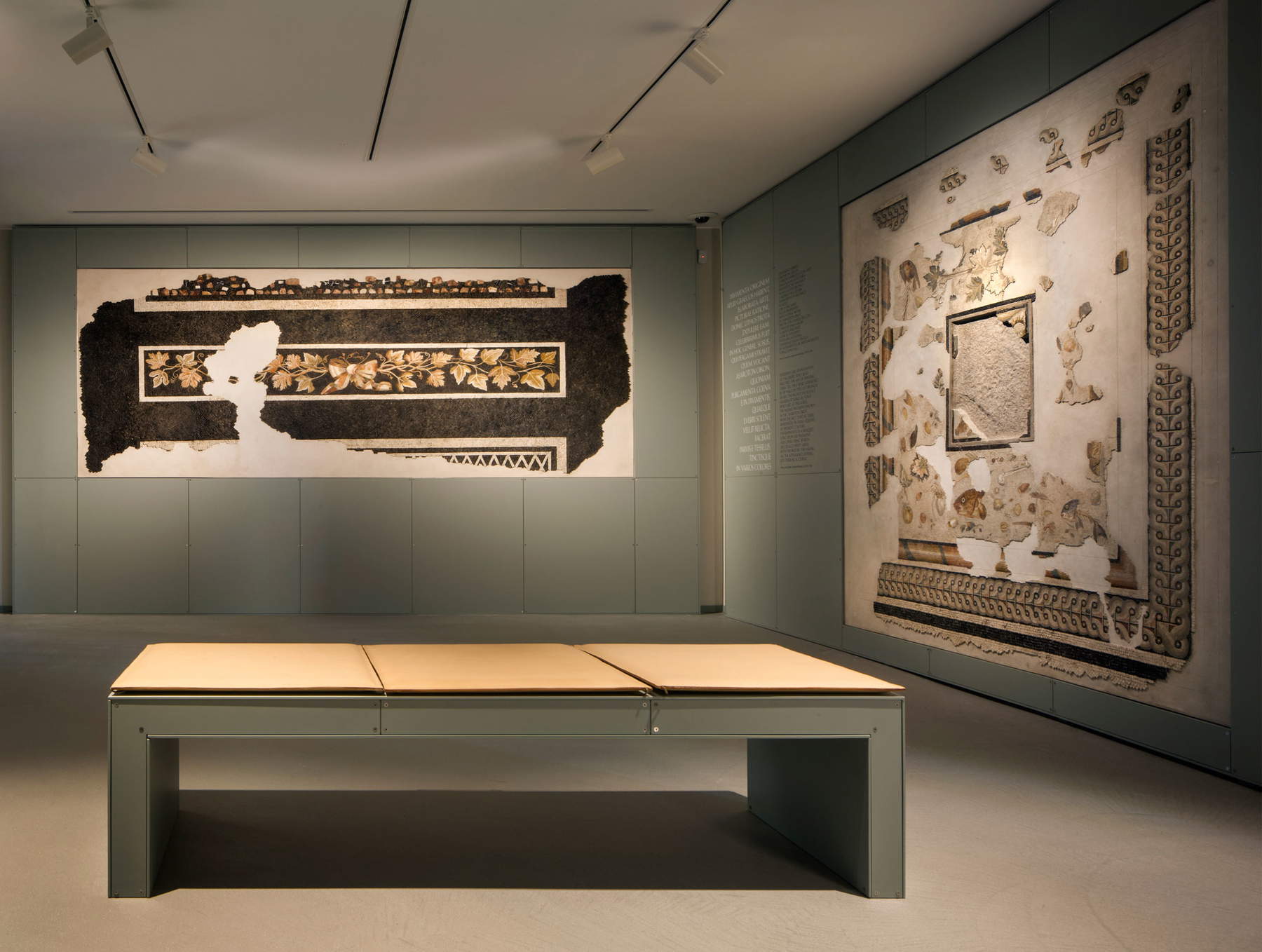 |
| Interior of the National Archaeological Museum of Aquileia. Ph. Credit Alessandra Chemollo, archives MAN Aquileia |
 |
| Interior of the National Archaeological Museum of Aquileia. Ph. Credit Alessandra Chemollo, MAN Aquileia archives. |
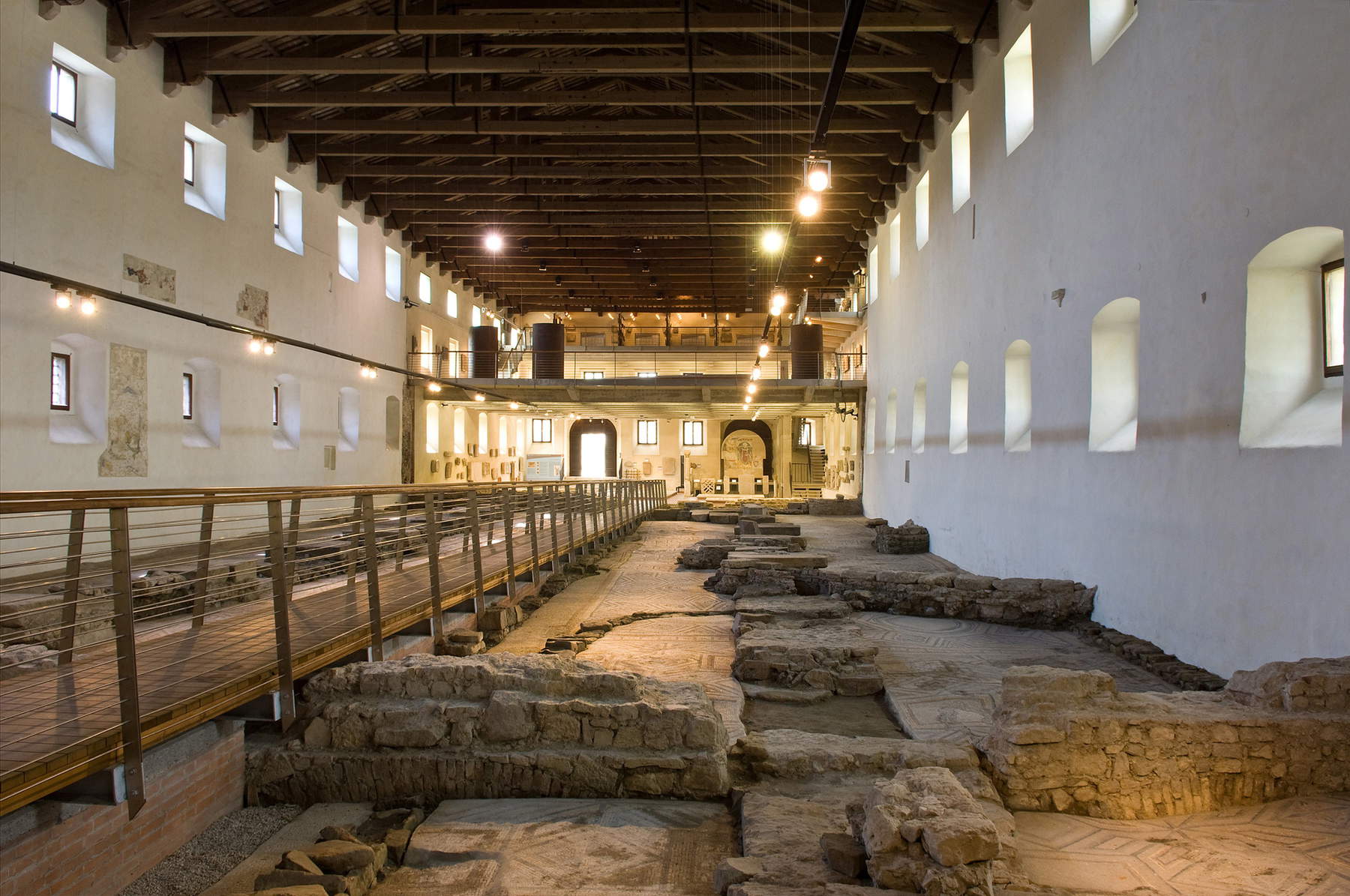 |
| Interior of the Early Christian Museum of Aquileia. Ph. Credit Gianluca Baronchelli |
When we think of mosaics, our minds fly to Ravenna, but it is perhaps little known that the city of Aquileia has the largest mosaic in the Western Christian world, precisely in the Basilica. Extending over 750 square meters, the floor mosaic now covers the area that formerly corresponded to the building’ssouthern hall, the South Hall of Theodore, one of the three rooms of the bishop’s seat erected at the time ofEmperor Constantine, and almost a third of it is dedicated to the story of Jonah. The latter is made explicit in the large fishing scene, where the fish represent people hearing the Good News, the boat represents the Church, and the net the Kingdom of Heaven. The three Jonah scenes, namely Jonah swallowed by the monster , Jonah rejected by the monster, and Jonah at rest under the gourd plant, allude to the death, resurrection, and ascension of Christ.
Other scenes appear in the large mosaic floor, also from the fourth century: the fight between the rooster and the tortoise , symbolizing the struggle between good (the rooster, light of the new day) and evil (the tortoise, which in Greek translation would mean “dweller of darkness”); the shepherd with the mystical flock, where Christ is depicted with the lost sheep on his shoulders and holding the shepherds’ syrinx. The detailed mosaic also includes portraits of benefactors, images of the Seasons and the Fish(Ichtys in Greek means fish, but it also stands for Iesús Christós Theoú Yiós Sotér, “Jesus Christ Son of God the Savior.”). Also present are images of the offerers and Christian Victory.
Corresponding instead to thenorth hall of the Basilica is the excavation crypt, where some mosaics around the foundations of the bell tower are still visible. This is anunderground archaeological area with remains from four different eras. Here, too, there is no shortage of mosaics with animals or objects with symbolic meanings alluding to faith, eternal life and Christian virtues.
Another sensational room is the crypt of frescoes, decorated with figures dating from the 12th century and denoting a special relationship between the Christian arts of East and West: on the vault are nineteen scenes with the Stories of Hermacoras narrating the origins of Christianity in Aquileia, while in the four lunettes appear scenes from the Passion of Christ and the Death of Mary. In the pendentives are noted figures of saints and in the central vault the Madonna Enthroned with Child between symbols of the Evangelists and Christ Enthroned between angels.
 |
| The Basilica of Aquileia. Ph. Credit Fabrice Gallina |
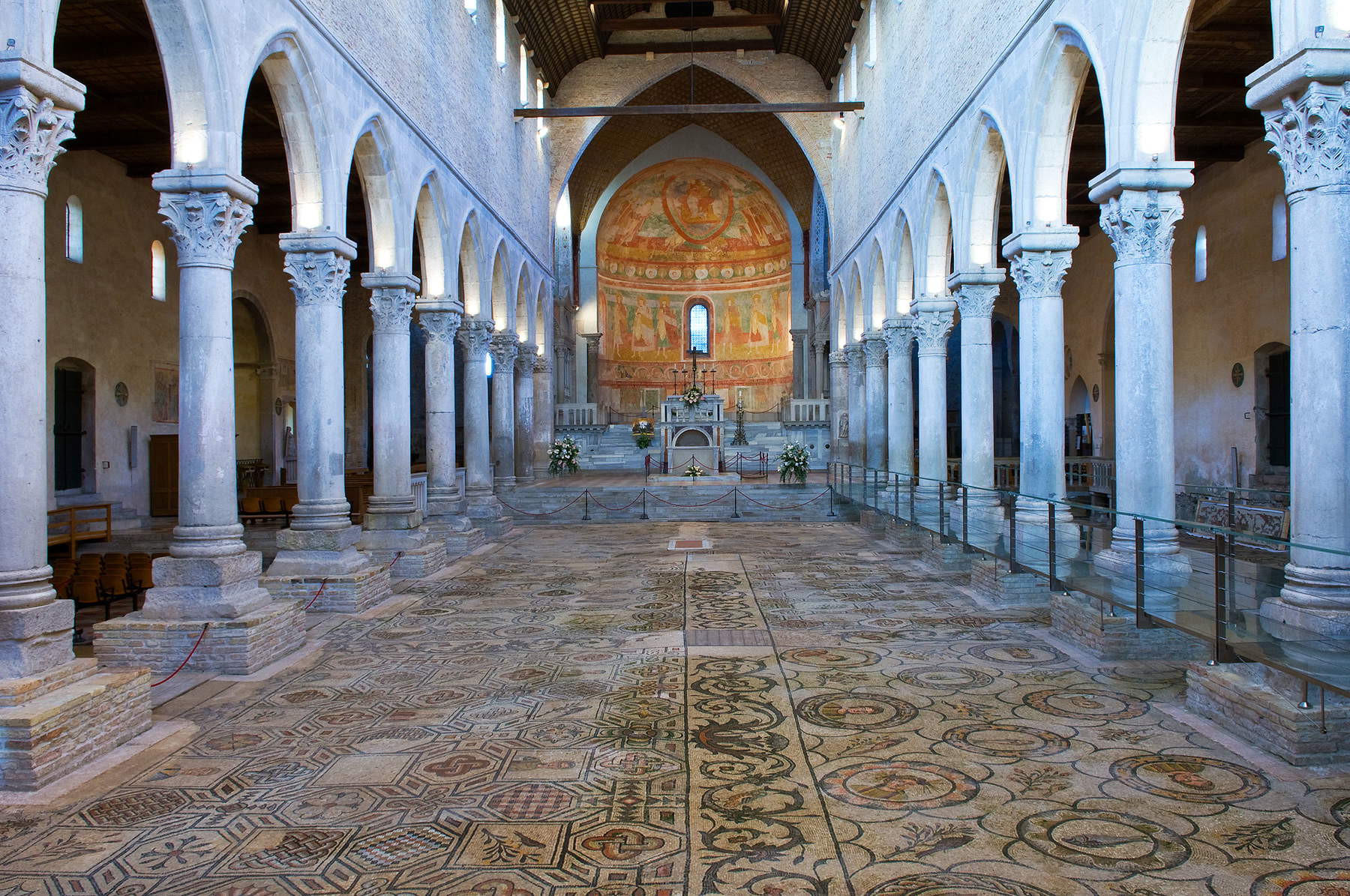 |
| Interior of the Basilica of Aquileia. Ph. Credit Gianluca Baronchelli |
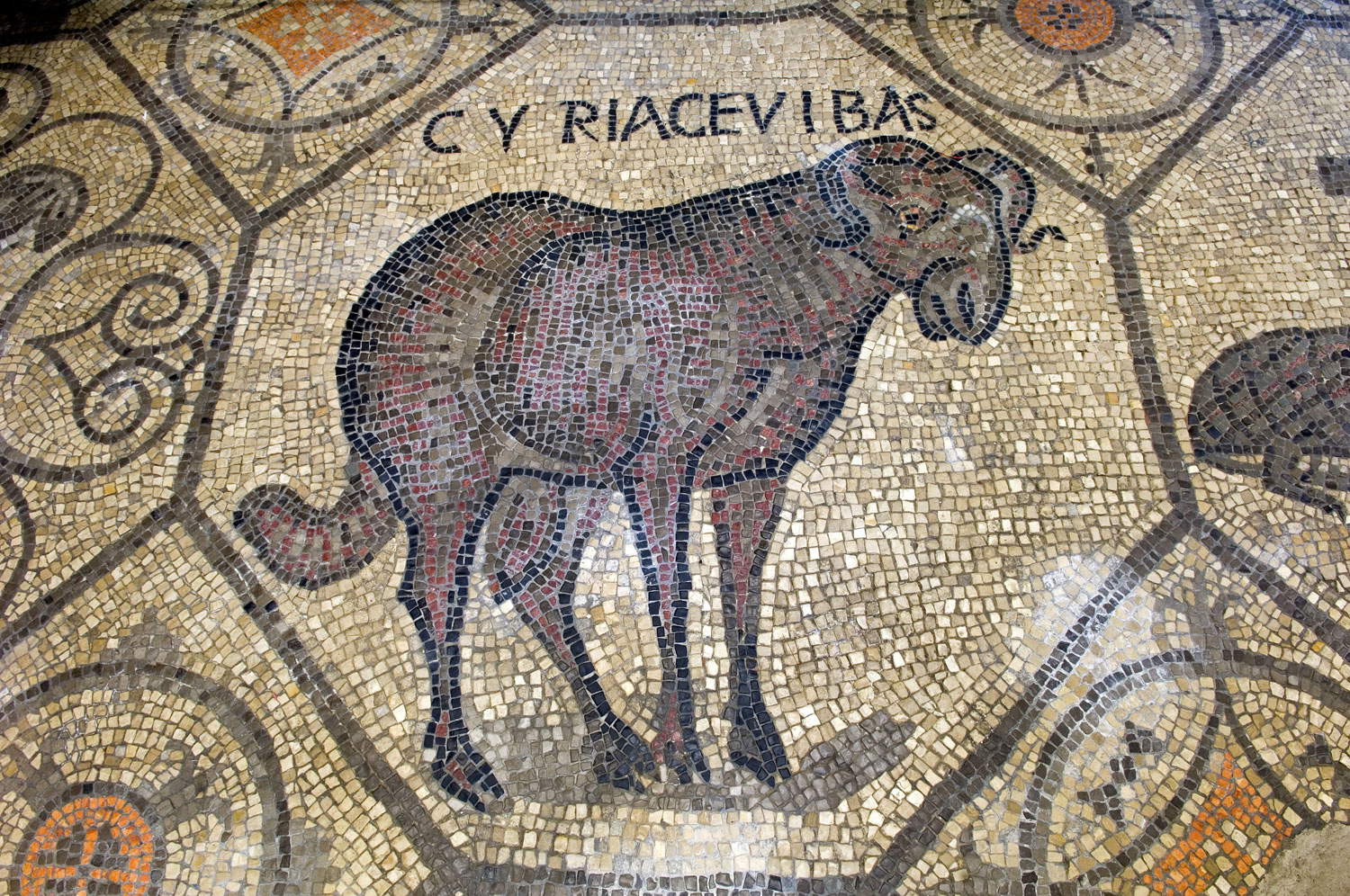 |
| One of the twelve lambs on the floor of the Basilica of Aquileia. Ph. Credit Gianluca Baronchelli |
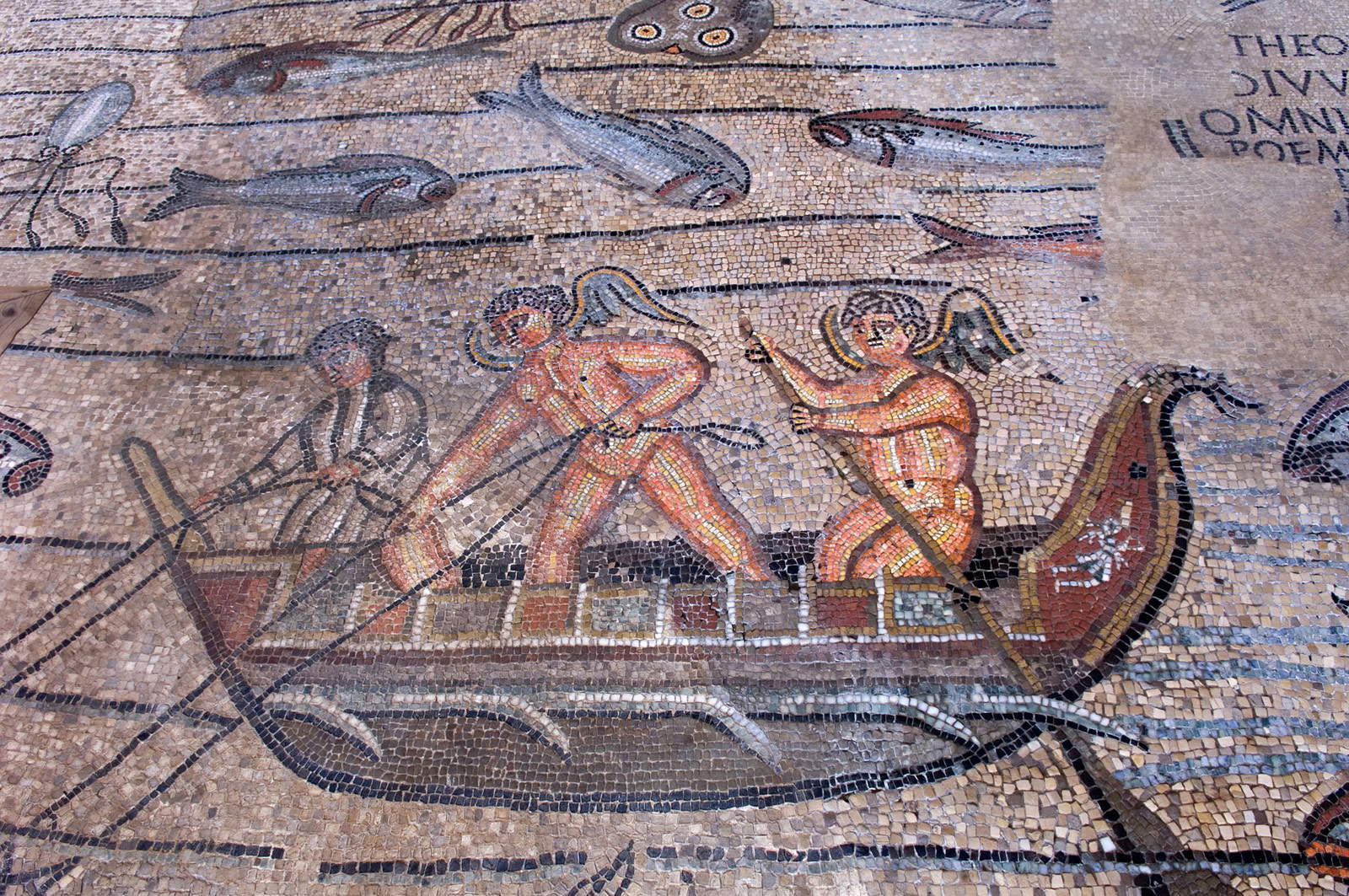 |
| Fishing scene in the floor of the Basilica of Aquileia. Ph. Credit Gianluca Baronchelli |
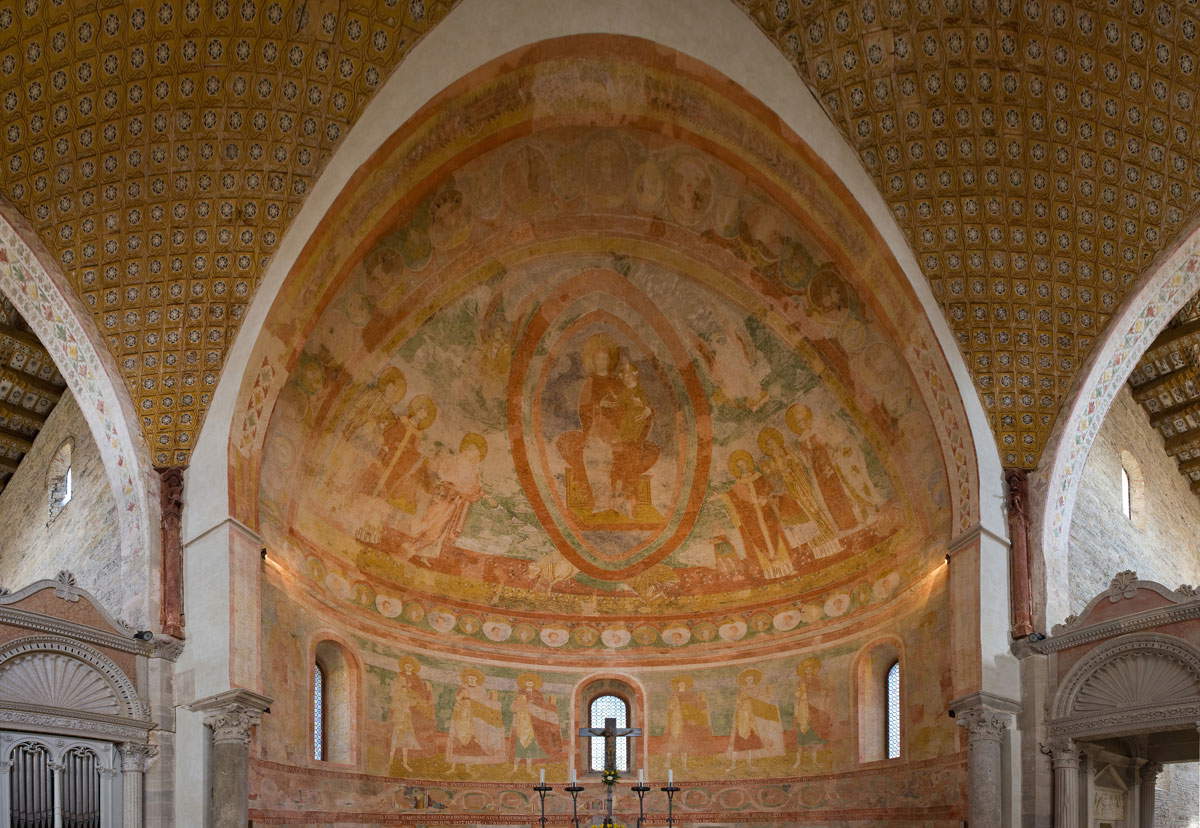 |
| Frescoes in the apse of the Basilica of Aquileia. Ph. Credit Gianluca Baronchelli |
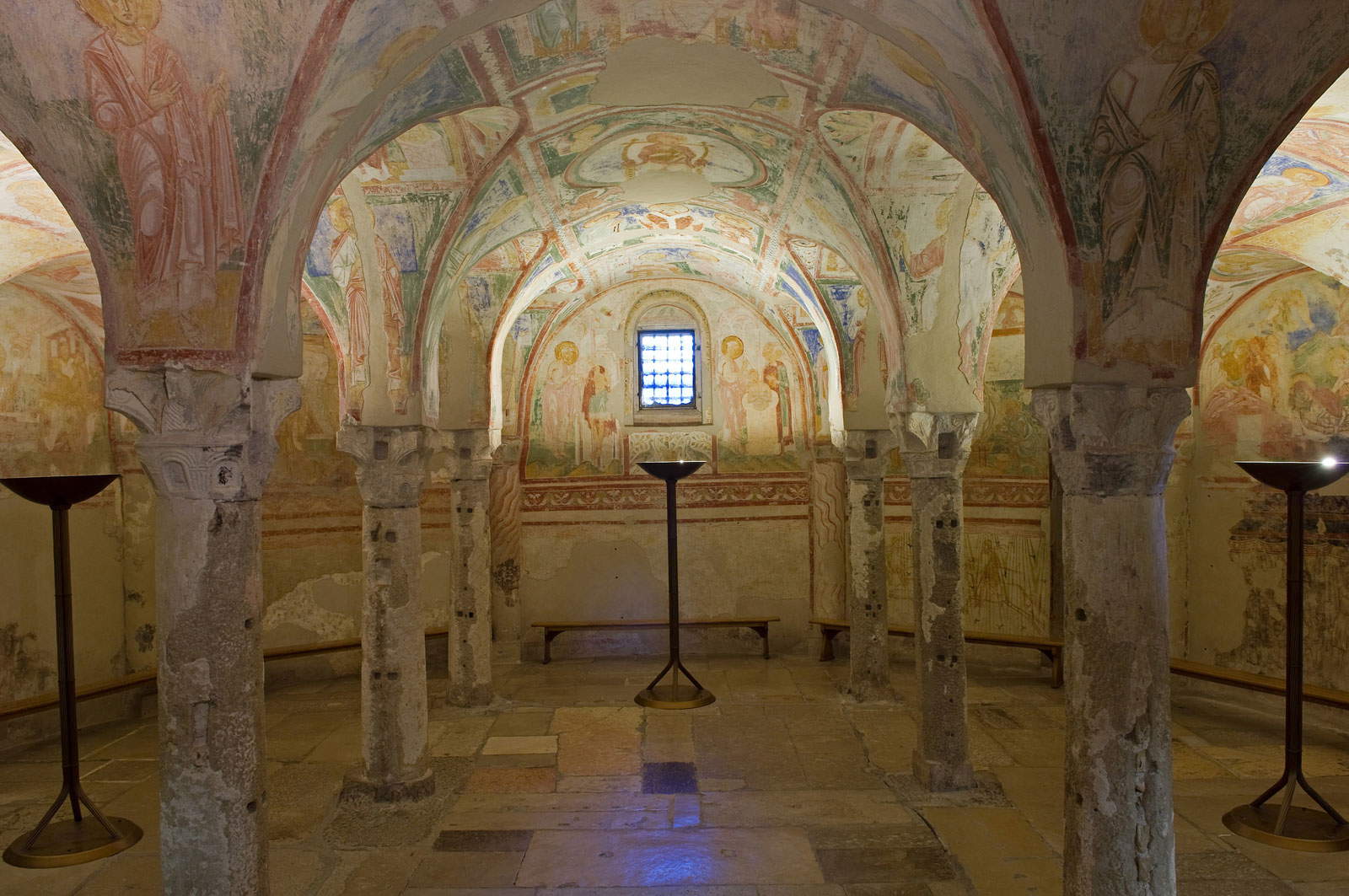 |
| Crypt of the frescoes. Ph. Credit Gianluca Baronchelli |
 |
| Crypt of the excavations. Ph. Credit Gianluca Baronchelli |
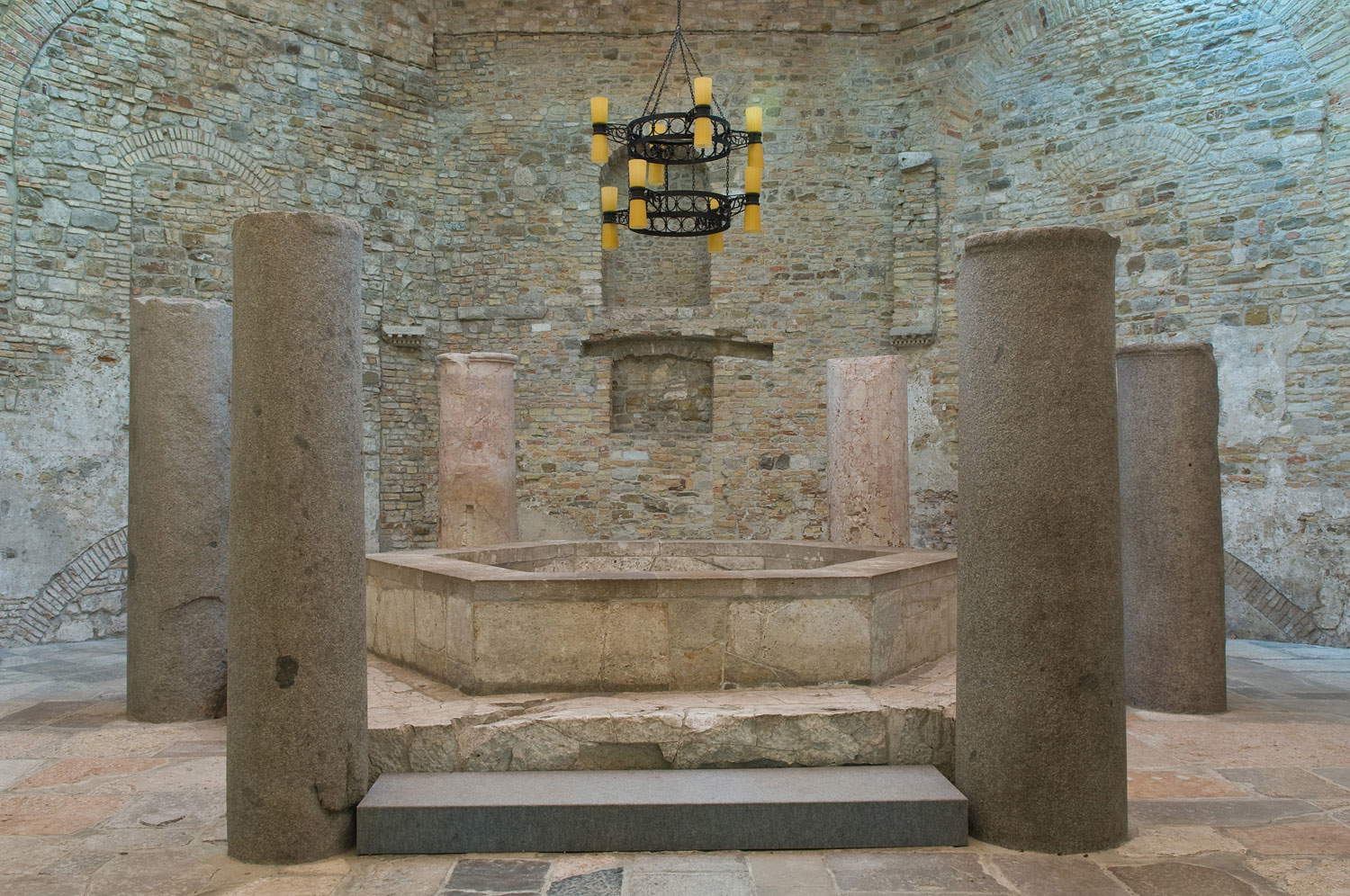 |
| The Chromatian baptistery. Ph. Credit Gianluca Baronchelli |
 |
| The peacock mosaic. Ph. Credit Gianluca Baronchelli |
With its spectacular rooms, the Basilica dedicated to the Virgin and Saints Hermacoras and Fortunatus is the largest and most visited monument in ancient Aquileia. Its present appearance derives from various reconstructions and modifications made over the centuries: after the destruction of the first church built in the years immediately following 313 AD, the inhabitants rebuilt it four times, following the principle according to which new buildings were superimposed on the remains of previous phases. However, the Basilica would be defined today by its Romanesque-Gothic forms, and within its complex are considered the baptistery and its south hall. Probably built at the end of the fourth or beginning of the fifth century (and for this reason known as the “Chromatian baptistery,” that is, dating back to the time when bishop of Aquileia was Chromatius, between 388 and 407), the baptistery has undergone various reconstructions over the centuries; it houses inside it a baptismal font suitable for baptisms by immersion, as was customary at that time. Its south hall, otherwise known as the Südhalle (the first archaeologists who worked in Aquileia were Austrians), preserves a floor mosaic with geometric figures, sheep or lambs, but above all the peacock mosaic, which originally decorated the passage leading from the baptistery to the basilica.
But Aquileia’s archaeological areas are not yet finished: the latest to be made accessible to the public is the Domus and Episcopal Palace area. A district of the ancient Roman city of which floor levels from different periods, the structures of the 1st-century Domus, the 4th-century apsidal hall and the mosaic and wall remains of the 5th-century Episcopal Palace are visible.
The Basilica with its crypts of frescoes and excavations, the Domus and the Episcopal Palace can also be visited on the special guided tourAquileia, the Ancient Metropolis of the Roman Empire, while the guided tourTheTreasures of the National Archaeological Museum of Aquileia leads visitors to discover the new layout of the National Archaeological Museum, where, as mentioned earlier, the exhibition Magnificent Returns is underway. Aquileian Treasures at the Kunsthistorisches Museum in Vienna. If, on the other hand, you prefer to walk around in total freedom, discovering with the help of theaudio guide the archaeological park of Aquileia, the Basilica, the National Archaeological Museum and all the other monumental sites of the city, you can follow Aquileia, the treasures of an ancient Roman metropolis. Walking tour with audio guide, service available year-round during Infopoint opening hours. All museums, exhibitions and guided tours are free for FVGcard holders. Aquileia is therefore a city that deserves to be visited and carefully admired, as it has an extraordinary repertoire of mosaics and archaeological finds that tell its ancient history as the main center for the spread of Christianity in Northern and Eastern Europe and as an important port connected to the entire Mediterranean.
Warning: the translation into English of the original Italian article was created using automatic tools. We undertake to review all articles, but we do not guarantee the total absence of inaccuracies in the translation due to the program. You can find the original by clicking on the ITA button. If you find any mistake,please contact us.